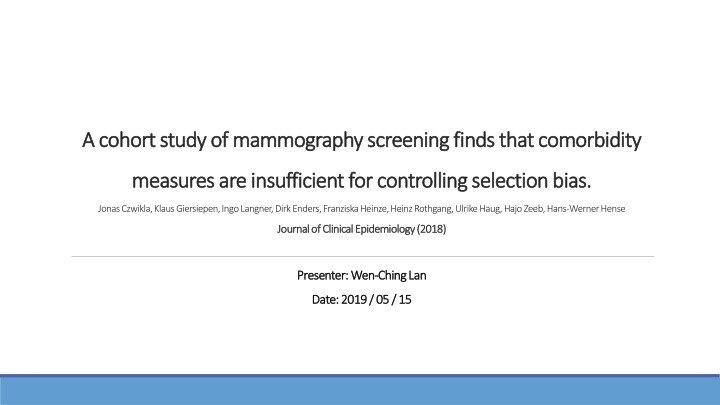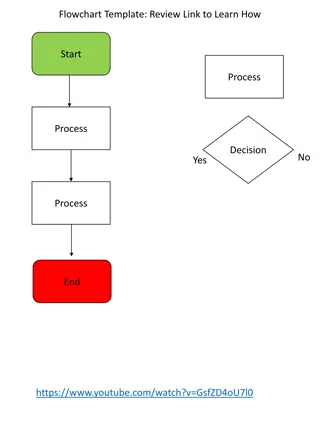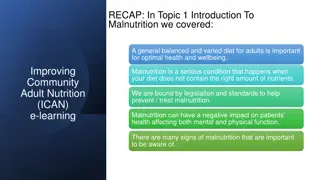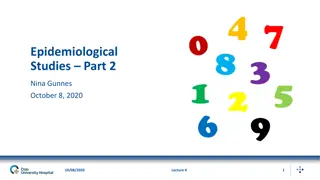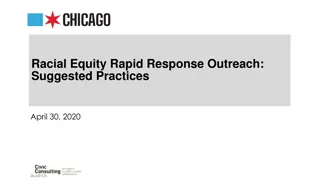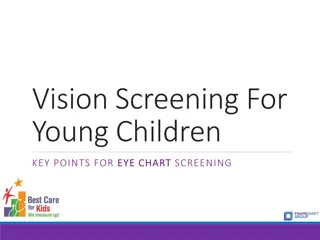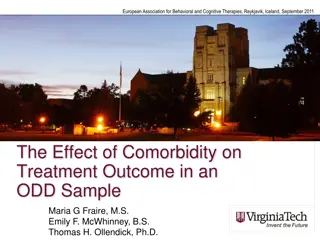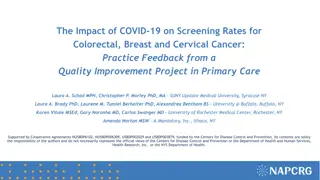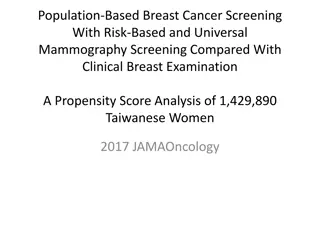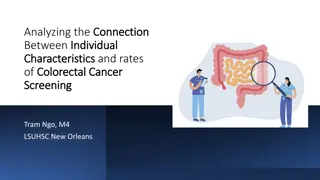Comorbidity Measures in Mammography Screening Cohort Study
Cohort study assessed the use of claims-based comorbidity measures to address selection bias in mammography screening. Data from 2007-2015 were analyzed to evaluate the effectiveness of different comorbidity measures. The study focused on women aged 50-68 and utilized SHI claims data from BARMER. Findings indicate the challenges in controlling selection bias with existing comorbidity measures.
Download Presentation

Please find below an Image/Link to download the presentation.
The content on the website is provided AS IS for your information and personal use only. It may not be sold, licensed, or shared on other websites without obtaining consent from the author.If you encounter any issues during the download, it is possible that the publisher has removed the file from their server.
You are allowed to download the files provided on this website for personal or commercial use, subject to the condition that they are used lawfully. All files are the property of their respective owners.
The content on the website is provided AS IS for your information and personal use only. It may not be sold, licensed, or shared on other websites without obtaining consent from the author.
E N D
Presentation Transcript
A cohort study of mammography screening finds that comorbidity A cohort study of mammography screening finds that comorbidity measures are insufficient for controlling selection bias. measures are insufficient for controlling selection bias. Jonas Czwikla, Klaus Giersiepen, Ingo Langner, Dirk Enders, FranziskaHeinze,Heinz Rothgang, Ulrike Haug, HajoZeeb, Hans-Werner Hense Journal of Clinical Epidemiology (2018) Journal of Clinical Epidemiology (2018) Presenter: Presenter: Wen Wen- -Ching ChingLan Lan Date: Date: 2019 / 05 / 15 2019 / 05 / 15
Introduction Introduction Randomized controlled trials (RCTs) are the gold standard for the evaluation of screening programs before their nationwide implementation. The comparison of all cause mortality between MSP participants and nonparticipants appears useful. Statutory Health Insurance (SHI) claims data represent the most comprehensive data source to test this hypothesis in the context of the German MSP. 1
Objective Objective The purpose of this study was to examine the potential of claims-based comorbidity measures for controlling selection bias in observational studies of mammography screening using the single comorbidities considered by the Charlson, Elixhauser, MACSS, and M3 comorbidity measures. 2
Materials and methods Materials and methods 2.1. Data source This study was based on pseudonymous SHI claims data covering the years from 2007-2015. The data were provided by the BARMER. demographic characteristics, insurance periods, inpatient and outpatient diagnoses, as well as outpatient therapeutic and diagnostic procedures were available. ICD-10-GM Outpatient procedures were coded according to the doctor s fee scale (Einheitlicher Bewertungsma stab [EBM]). 3
Materials and methods Materials and methods 2.2. Study design and population Retrospective cohort study (over a 2-year period covering the invitation years 2010 and 2011. ) Women with the specific EBM code 01750 MSP participants Main analysis (cohort I) 1. Age 50-68 years in 2010 2. Continuous insurance between January 1, 2007 and December 31, 2011. 3. No inpatient or outpatient : ICD-10-GM C50 or ICD-10-GM Z85.3 in 2007, 2008 or 2009 . 4
Materials and methods Materials and methods Start date set at January 1, 2012. End date (1)death, (2)end of continuous insurance, (3)December 31, 2015 Sensitivity analysis using an index date approach (cohort II) 2007-2009 5
Materials and methods Materials and methods 2.3. Identification of comorbidity Based on main and secondary hospital discharge diagnoses. Cohort1 (1)2010-2011, (2) 2009, (3) 2008-2009, (4) 2007-2009, (5)2007-2011. Cohort2 (6) 1 year before cohort entry, (7) 2 years before cohort entry, (8) 3 years before cohort entry. 6
Materials and methods Materials and methods 2.4. Statistical analysis 1. Cox proportional hazards regression 1) Crude 2) Adjusted age in 2010 and federal state of residence 3) Charlson, Elixhauser, MACSS, or M3 comorbidity measure 2. Propensity score estimates were used for a Greedy 5 1 Digit Matching 1:1 SAS Enterprise Guide 7.1. 7
Results Results 8
Results Results 9
Results Results 10
Discussion Discussion MSP may reduce breast cancer mortality by about 20% , one would theoretically expect all- cause mortality in this population to be decreased by 1.8%. After adjustment for age, federal state of residence and the single comorbidities considered by the Charlson, Elixhauser, MACSS, or M3 comorbidity measure, participants were still at least 48% less likely to die, suggesting an insufficient control of selection bias. healthy volunteer bias 11
Strengths Strengths 1. Two established and two new claimsbased comorbidity measures to examine 2. comprised 9 years of longitudinal data for more than 1.24 million continuously insured women eligible for MSP participation, allowing precise estimates of selection bias. 12
limitations limitations 1. German SHI claims data contain no information on the specific cause of death. 2. To examine selection bias, we used rather short follow-up periods. 3. MSP invitation dates are not available in Germany. 13
Conclusions Conclusions Mammography screening participants and nonparticipants are not comparable in terms of their health status. It is not sufficient to use the single comorbidities considered by the Charlson, Elixhauser, MACSS, or M3 comorbidity measure for controlling selection bias in observational studies of mammography screening. 14
Thanks for listening. Thanks for listening.
